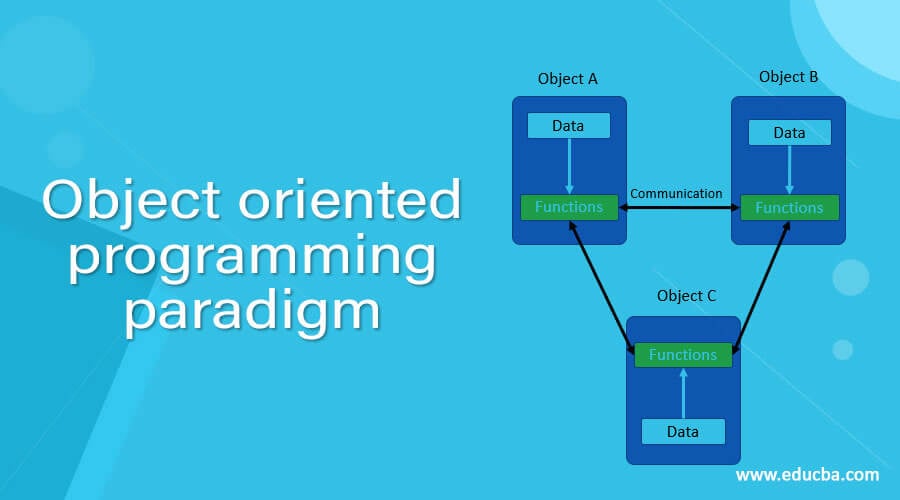
Introduction to Object oriented programming paradigm
The main necessity behind inventing object oriented approach is to remove the drawback encountered in the procedural approach. The programming paradigm object treats data as an element in the program development and holds it tightly rather than allowing it to move freely around the system. It ties the data to the function that operates on it and hides and protects it from accidental updates by external functions. Object oriented programming paradigm allows decomposition of the system into the number of entities called objects and then ties properties and function to these objects. An object’s properties can be accessed only by the functions associated with that object but functions of one object can access the function of other objects in the same cases using access specifiers.
Why do we need the object oriented programming paradigm?
Object-oriented programming paradigm methods enable us to create a set of objects that work together to produce software that is better understandable and models their problem domains than produced using traditional techniques. The software produced using object-oriented programming paradigm is easier to adapt to the changing requirements, easier to maintain, create modules of functionality, promote greater design, be more robust, and perform desired work efficiently.
Object orientation techniques work more efficiently than traditional techniques due to the following reasons.
- The higher level of abstraction: Top-down approach support abstraction at the Functional level while object oriented approach support abstraction at the object level.
- The seamless transition among different software development phases: It uses the same language for all phases, which reduces the level of complexity and redundancy makes software development clear and robust.
- Good programming practice: The subroutine and attributes of a class are held together tightly.
- Improves reusability: it supports inheritance due to which classes can be built from each other. So only difference and enhancement between classes need to be designed and coded. All the previous functionality remains as it is and can be used without change.
Basic concepts of object oriented programming paradigm
- Objects: Objects are nothing but real or abstract items that contain data to define the object and methods that can manipulate that information. Thus the object is a combination of data and methods.
- Classes: Class is a group of objects that has the same properties and behavior and the same kind of relationship and semantics. Once a class has been defined, we can create any number of objects belonging to thy class. Objects are variables of the class. Each object is associated with data of the type class with which they are created; this class is the collection of objects of a similar type.
- Encapsulation: Encapsulation is the process of wrapping up data and functions into a single unit. It is the most striking feature of the class. Data is not accessible to the outside world, and only those functions which are wrapped in the class can access it. It provides the interface between data objects and the program.
- Abstraction: Abstraction represents essential features. It does not represent the background details and explanation. Classes use the concept of abstraction and define the list of abstract attributes such as name, age, gender, etc., to operate on these attributes. They encapsulate all the essential properties of the object.
- Inheritance: Inheritance is the property whereby one class extends another class’s properties, including additional methods and variables. The original class is called a superclass, and the class that exceeds the properties are called a subclass. As the subclass contains all the data of the superclass, it is more specific.
- Polymorphism: In geek terms, polymorphism means the ability to take more than one form. An operation may exhibit different behavior in a different instance. Behavior depends on the types of data used for the operation.
- Messaging: Object oriented system consists of sets of objects that communicate with each other. Object communicate with one another by sending and receiving data much the same way as people pass messages to one another. A message for the object is a request for execution of a method and, therefore, will invoke a method in the receiving object that generates the desired result.
Features of object oriented programming paradigm
- Programs are divided into simple elements referred to as object
- Focus is on properties and functions rather than procedure.
- Data is hidden from external functions.
- Functions operate on the properties of an object.
- Objects may communicate with each other through a function called messaging.
- Follow the bottom-up approach in oop design
Conclusion
Object orientation is so-called because this method sees things that are part of the real world of objects. In this article, we have discussed the basic concepts of the object oriented programming paradigm. I hope it helps you.
Recommended Articles
This is a guide to Object oriented programming paradigm. Here we discuss why we need the object-oriented programming paradigm and the basic concepts and features. You may also have a look at the following articles to learn more –
